Casual restaurant chain Portillo’s (NASDAQ:PTLO) missed analysts' expectations in Q1 CY2024, with revenue up 6.3% year on year to $165.8 million. It made a GAAP profit of $0.08 per share, improving from its loss of $0.01 per share in the same quarter last year.
Portillo's (PTLO) Q1 CY2024 Highlights:
- Revenue: $165.8 million vs analyst estimates of $174.9 million (5.2% miss)
- Adjusted EBITDA: $21.8 million vs analyst estimates of $22.3 million (2.2% miss)
- EPS: $0.08 vs analyst estimates of $0.06 (26% beat)
- Gross Margin (GAAP): 21.9%, down from 22.3% in the same quarter last year
- Free Cash Flow was -$7.86 million compared to -$13.05 million in the previous quarter
- Same-Store Sales were down 1.2% year on year
- Store Locations: 85 at quarter end, increasing by 10 over the last 12 months
- Market Capitalization: $746.4 million
Begun as a Chicago hot dog stand in 1963, Portillo’s (NASDAQ:PTLO) is a casual restaurant chain that serves Chicago-style hot dogs and beef sandwiches as well as fries and shakes.
In addition to the signature dogs and sandwiches, Portillo’s is known for its decadent chocolate cake. Not everything will expand your waistline, though, as the chain has expanded its offerings to include healthier options such as salads and chicken breast sandwiches.
The core Portillo’s customer is diverse. Maybe it’s someone looking for convenient and indulgent food that’s a bit unique compared to the typical fast food menu. Perhaps it’s a family looking for a weekend treat where everyone can find something they like on the menu. Maybe it’s a Chicago native looking for that comfort food from the old neighborhood.
Portillo’s locations feature retro diner themes to ramp up the nostalgia and lively atmosphere. There are tables and booths that are often a feature of diners. Vintage photos featuring Chicago landmarks, celebrities, or pop culture line the walls to remind everyone of the restaurant’s roots.
Traditional Fast Food
Traditional fast-food restaurants are renowned for their speed and convenience, boasting menus filled with familiar and budget-friendly items. Their reputations for on-the-go consumption make them favored destinations for individuals and families needing a quick meal. This class of restaurants, however, is fighting the perception that their meals are unhealthy and made with inferior ingredients, a battle that's especially relevant today given the consumers increasing focus on health and wellness.
Competitors offering convenient comfort food that can sometimes conjure nostalgia include Potbelly (NASDAQ:PBPB), Shake Shack (NYSE:SHAK), Brinker International (NYSE:EAT), and The Cheesecake Factory (NASDAQ:CAKE).Sales Growth
Portillo's is a small restaurant chain, which sometimes brings disadvantages compared to larger competitors benefitting from better brand awareness and economies of scale.
As you can see below, the company's annualized revenue growth rate of 9.4% over the last four years (we compare to 2019 to normalize for COVID-19 impacts) was decent as it opened new restaurants and grew sales at existing, established dining locations.
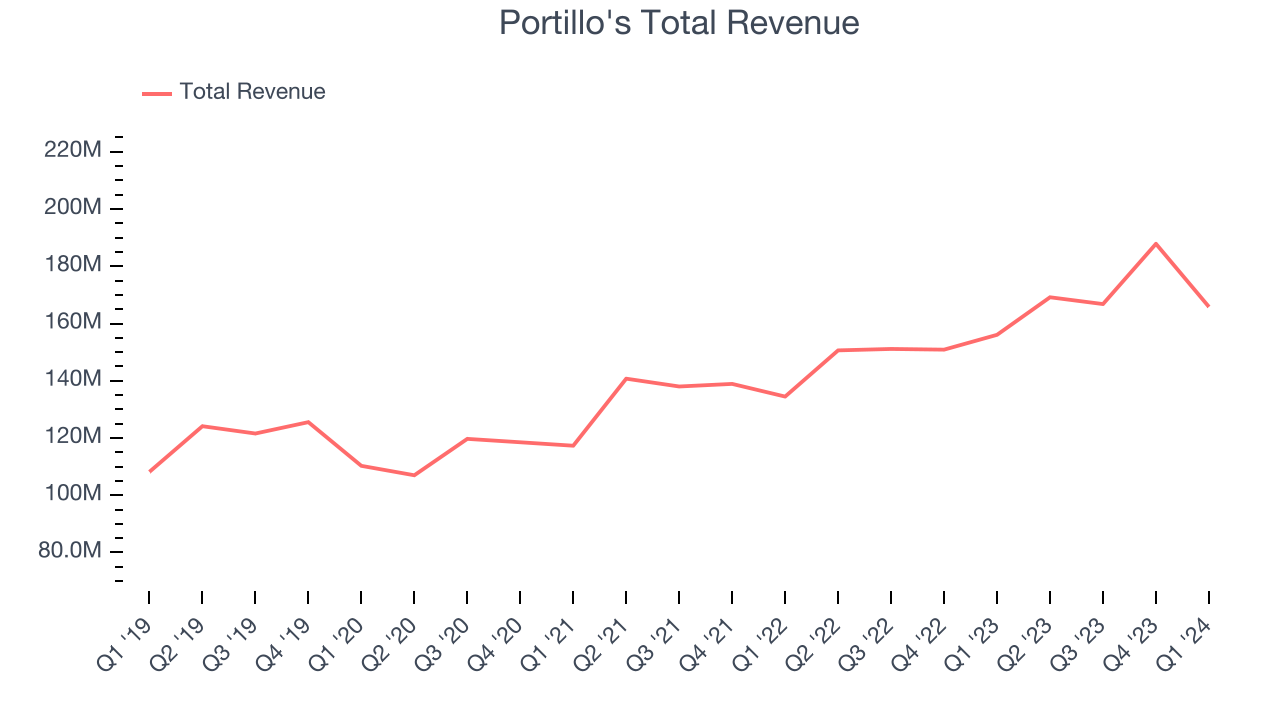
This quarter, Portillo's revenue grew 6.3% year on year to $165.8 million, missing Wall Street's expectations. Looking ahead, Wall Street expects sales to grow 13.2% over the next 12 months, an acceleration from this quarter.
Same-Store Sales
A company's same-store sales growth shows the year-on-year change in sales for its restaurants that have been open for at least a year, give or take. This is a key performance indicator because it measures organic growth and demand.
Portillo's demand within its existing restaurants has generally risen over the last two years but lagged behind the broader sector. On average, the company's same-store sales have grown by 4.5% year on year. With positive same-store sales growth amid an increasing number of restaurants, Portillo's is reaching more diners and growing sales.
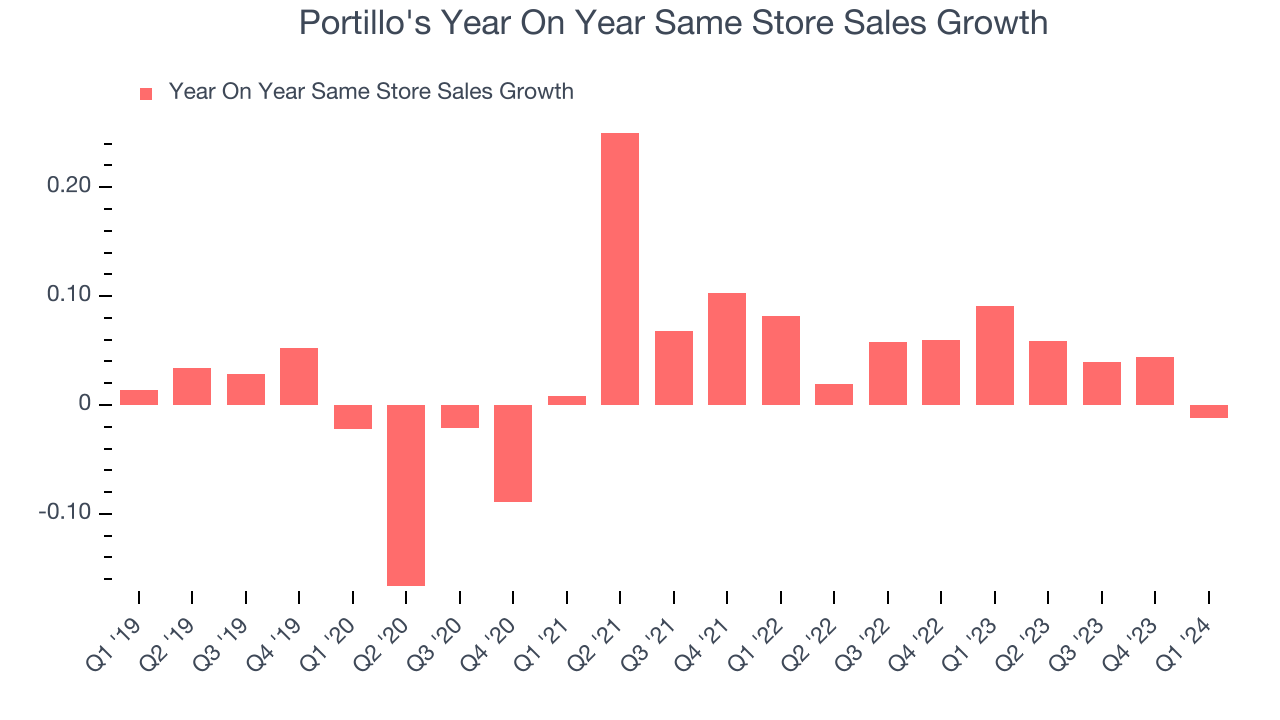
In the latest quarter, Portillo's same-store sales fell 1.2% year on year. This decline was a reversal from the 9.1% year-on-year increase it posted 12 months ago. We'll be keeping a close eye on the company to see if this turns into a longer-term trend.
Number of Stores
The number of dining locations a restaurant chain operates is a major determinant of how much it can sell and how quickly company-level sales can grow.
When a chain like Portillo's is opening new restaurants, it usually means it's investing for growth because there's healthy demand for its meals and there are markets where the concept has few or no locations. Portillo's restaurant count increased by 10, or 13.3%, over the last 12 months to 85 locations in the most recently reported quarter.
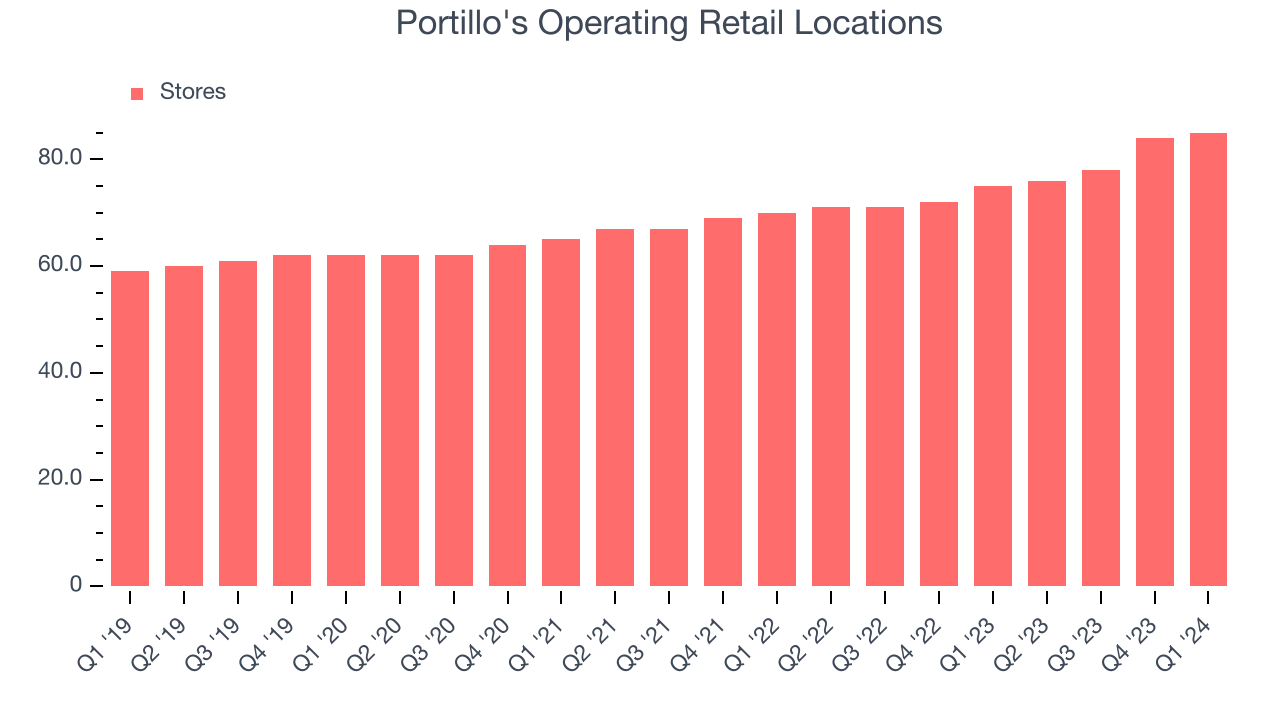
Over the last two years, Portillo's has rapidly opened new restaurants, averaging 8.8% annual increases in new locations. This growth is among the fastest in the restaurant sector and gives Portillo's a chance to scale towards a mid-sized company over time. Analyzing a restaurant's location growth is important because expansion means Portillo's has more opportunities to feed customers and generate sales.
Gross Margin & Pricing Power
Portillo's gross profit margin came in at 21.9% this quarter. in line with the same quarter last year. This means the company makes $0.24 for every $1 in revenue before accounting for its operating expenses.
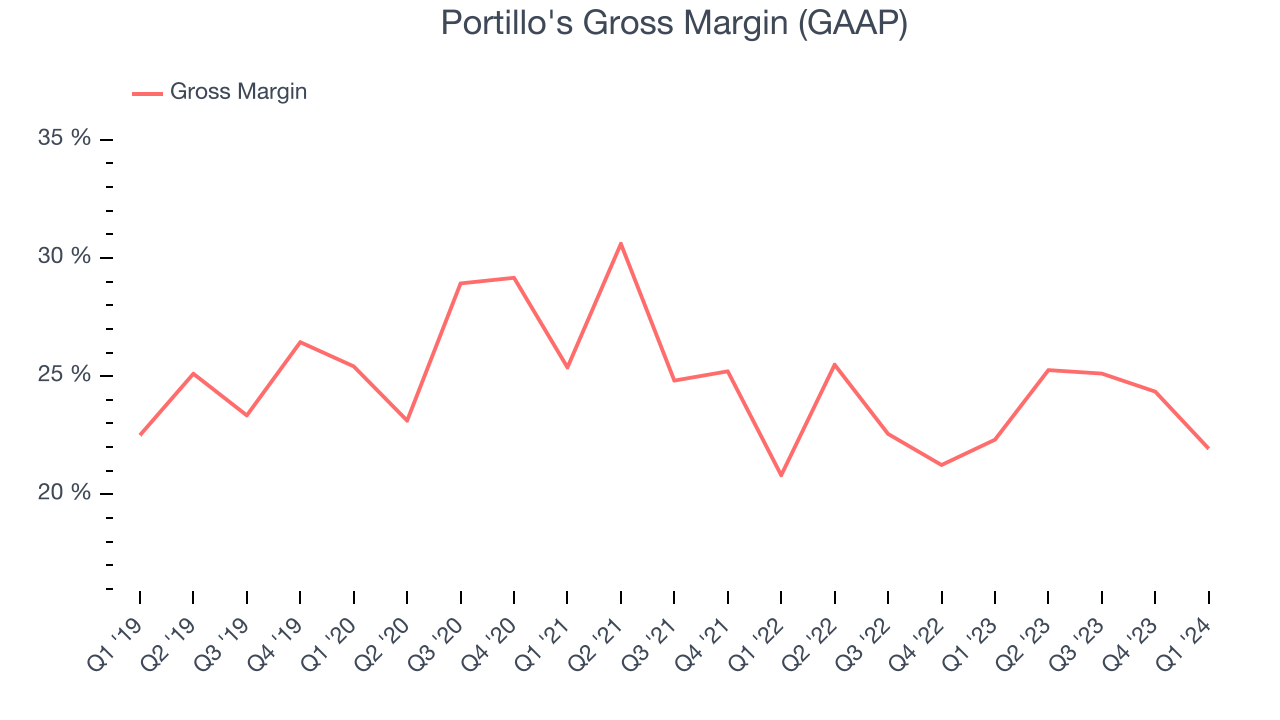
Portillo's has subpar unit economics for a restaurant company, making it difficult to invest in areas such as marketing and talent to grow its brand. As you can see above, it's averaged a paltry 23.6% gross margin over the last two years. Its margin, however, has been trending up over the last 12 months, averaging 5.8% year-on-year increases each quarter. If this trend continues, it could suggest a less competitive environment.
Operating Margin
Operating margin is a key profitability metric for restaurants because it accounts for all expenses keeping the lights on, including wages, rent, advertising, and other administrative costs.
This quarter, Portillo's generated an operating profit margin of 6.1%, in line with the same quarter last year. This indicates the company's costs have been relatively stable.
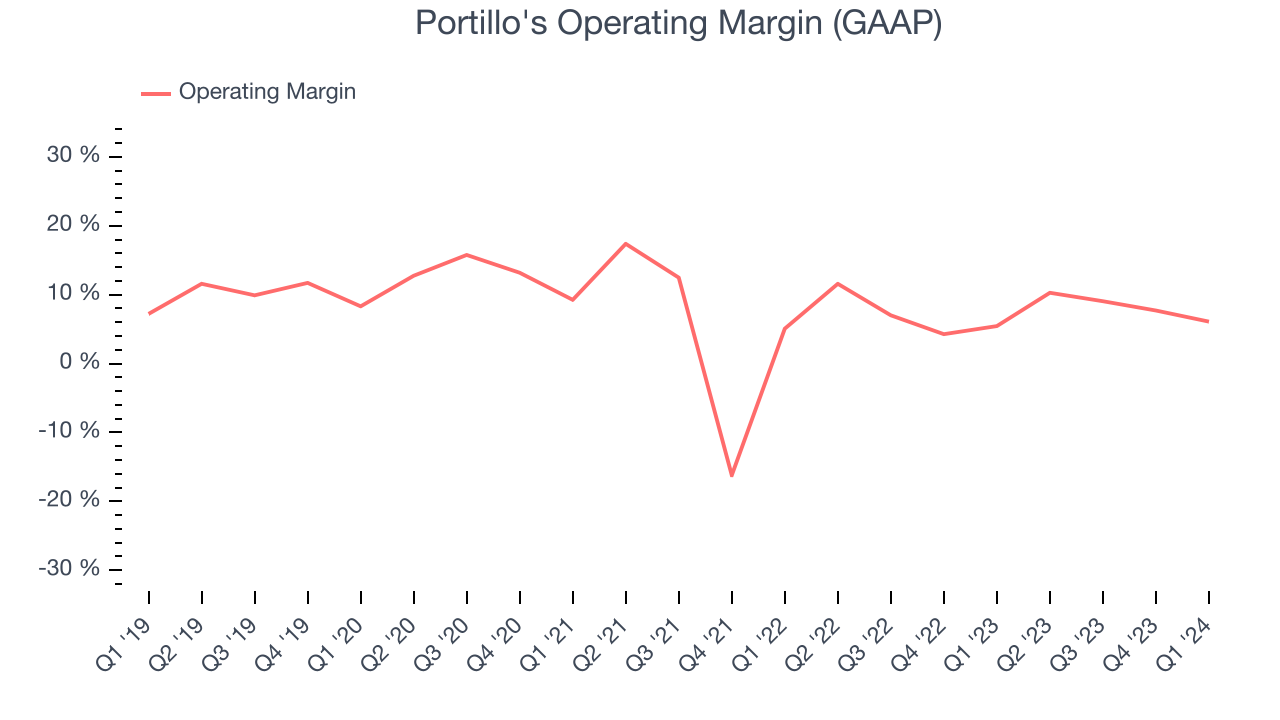 Zooming out, Portillo's was profitable over the last two years but held back by its large expense base. It's demonstrated mediocre profitability for a restaurant business, producing an average operating margin of 7.7%. However, Portillo's margin has improved, on average, by 1.2 percentage points each year, showing the company is heading in the right direction.
Zooming out, Portillo's was profitable over the last two years but held back by its large expense base. It's demonstrated mediocre profitability for a restaurant business, producing an average operating margin of 7.7%. However, Portillo's margin has improved, on average, by 1.2 percentage points each year, showing the company is heading in the right direction.EPS
These days, some companies issue new shares like there's no tomorrow. That's why we like to track earnings per share (EPS) because it accounts for shareholder dilution and share buybacks.
In Q1, Portillo's reported EPS at $0.08, up from negative $0.01 in the same quarter a year ago. This print beat Wall Street's estimates by 26%.
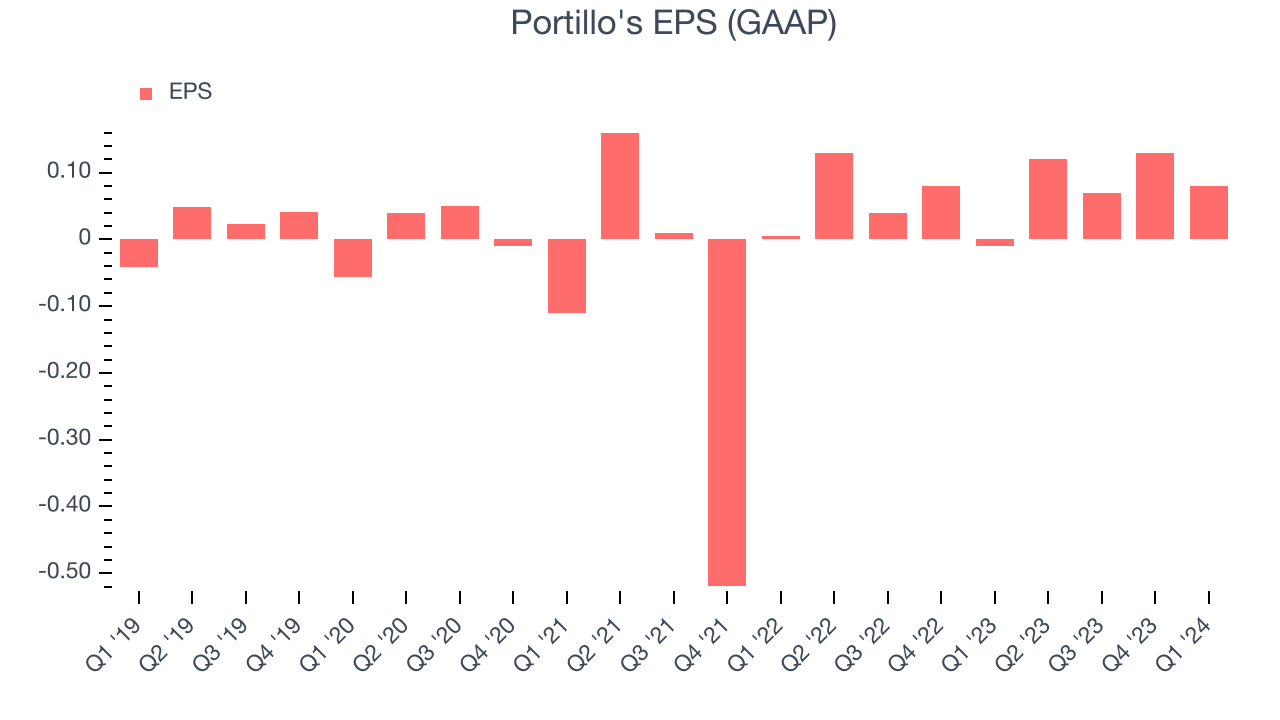
Between FY2020 and FY2024, Portillo's adjusted diluted EPS grew 607%, translating into an astounding 63.1% compounded annual growth rate. This growth is materially higher than its revenue growth over the same period, showing that Portillo's has excelled in managing its expenses.
Wall Street expects the company to continue growing earnings over the next 12 months, with analysts projecting an average 10.8% year-on-year increase in EPS.
Cash Is King
If you've followed StockStory for a while, you know that we emphasize free cash flow. Why, you ask? We believe that in the end, cash is king, and you can't use accounting profits to pay the bills.
Portillo's burned through $7.86 million of cash in Q1, representing a negative 4.7% free cash flow margin. The company increased its cash burn by 42.7% year on year.
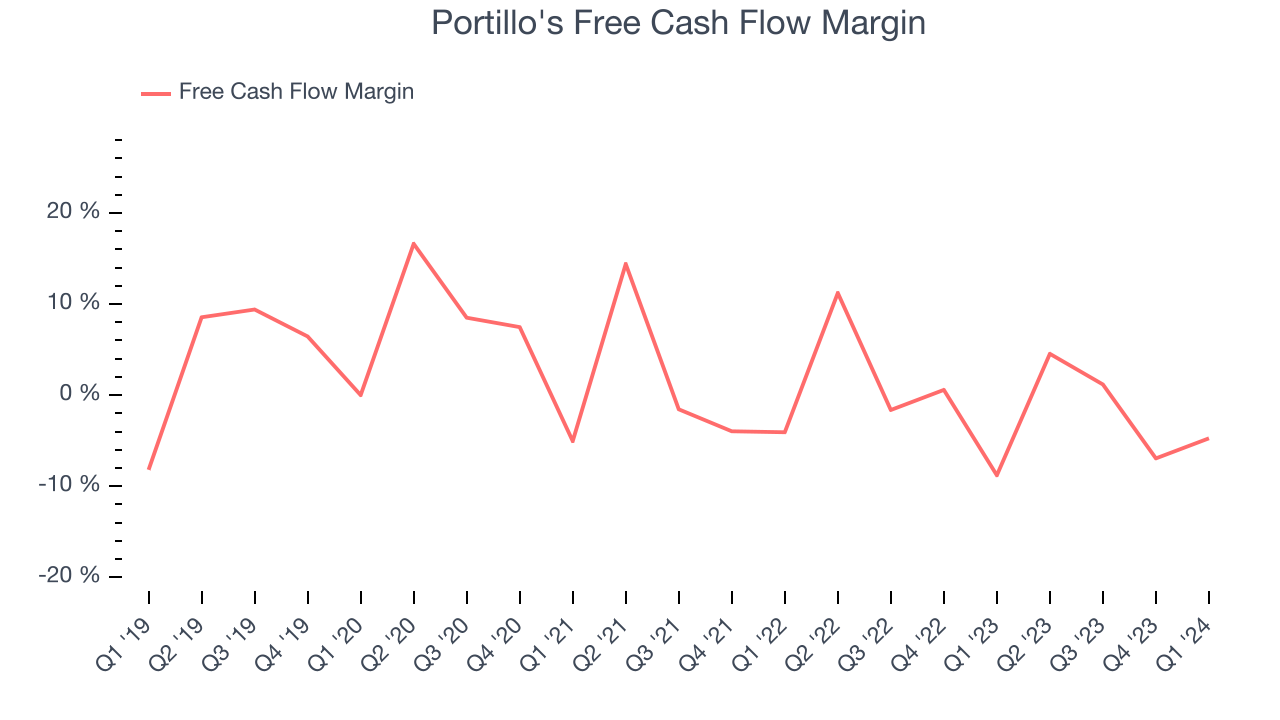
Over the last two years, Portillo's capital-intensive business model and large investments in new restaurant locations have drained company resources. Its free cash flow margin has been among the worst in the restaurant sector, averaging negative 0.7%. Furthermore, Portillo's margin has averaged year-on-year declines of 1.9 percentage points. Investors likely aren't thrilled about the company's margin trajectory and would hope to see a reversal soon.
Return on Invested Capital (ROIC)
EPS and free cash flow tell us whether a company was profitable while growing revenue. But was it capital-efficient? A company’s ROIC explains this by showing how much operating profit a company makes compared to how much money the business raised (debt and equity).
Portillo's five-year average ROIC was 6.9%, somewhat low compared to the best restaurant companies that consistently pump out 15%+. Its returns suggest it historically did a subpar job investing in profitable business initiatives.
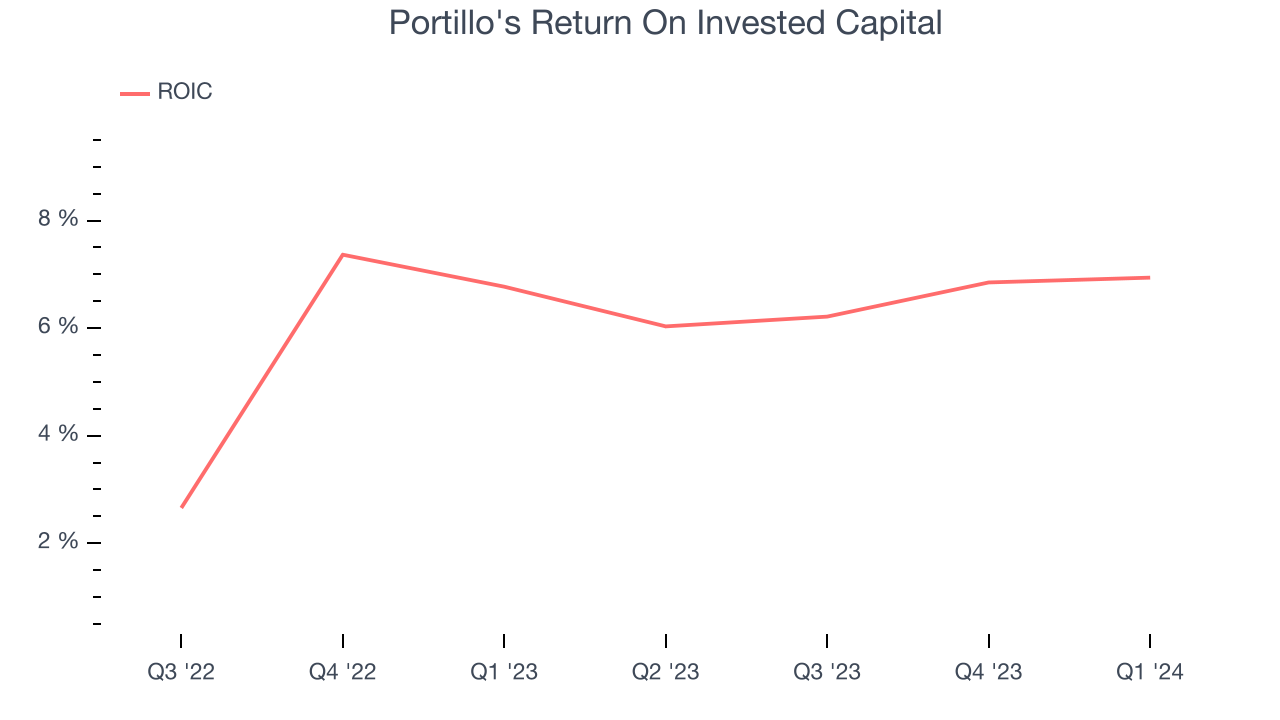
Balance Sheet Risk
Debt is a tool that can boost company returns but presents risks if used irresponsibly.
Portillo's reported $13.18 million of cash and $529.5 million of debt on its balance sheet in the most recent quarter. As investors in high-quality companies, we primarily focus on two things: 1) that a company's debt level isn't too high and 2) that its interest payments are not excessively burdening the business.
With $104.4 million of EBITDA over the last 12 months, we view Portillo's 4.9x net-debt-to-EBITDA ratio as safe. We also see its $13.36 million of annual interest expenses as appropriate. The company's profits give it plenty of breathing room, allowing it to continue investing in new initiatives.
Key Takeaways from Portillo's Q1 Results
Portillo's revenue and adjusted EBITDA unfortunately missed analysts' expectations. Overall, the results could have been better. The company is down 4.7% on the results and currently trades at $11.55 per share.
Is Now The Time?
Portillo's may have had a tough quarter, but investors should also consider its valuation and business qualities when assessing the investment opportunity.
Portillo's isn't a bad business, but it probably wouldn't be one of our picks. Although its revenue growth has been solid over the last four years and its growth over the next 12 months is expected to be higher, its cash burn raises the question of whether it can sustainably maintain growth. And while its new restaurant openings have increased its brand equity, the downside is its brand caters to a niche market.
Portillo's price-to-earnings ratio based on the next 12 months is 29.4x. In the end, beauty is in the eye of the beholder. While Portillo's wouldn't be our first pick, if you like the business, the shares are trading at a pretty interesting price right now.
Wall Street analysts covering the company had a one-year price target of $20.20 per share right before these results (compared to the current share price of $11.55).
To get the best start with StockStory, check out our most recent stock picks, and then sign up to our earnings alerts by adding companies to your watchlist here. We typically have the quarterly earnings results analyzed within seconds of the data being released, and especially for companies reporting pre-market, this often gives investors the chance to react to the results before the market has fully absorbed the information.
